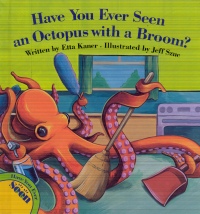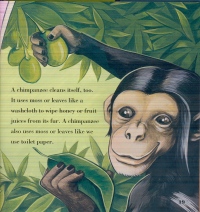| ________________
CM . . .
. Volume XVI Number 7. . . .October 16, 2009 
 |
Have You Ever Seen an Octopus with a Broom?
Etta Kaner. Illustrated by Jeff Szuc.
Toronto, ON: Kid Can Press, 2009.
32 pp., hardcover, $14.95.
ISBN 978-1-55453-247-6.
Subject Heading:
Tool use in animals-Juvenile literature.
Preschool-grade 2 / Ages 4-7.
Review by Devon Greyson.
** /4
|
| |
|

excerpt:
Have you ever seen an ant with a shopping bag?
That's silly.
I carry food home with a shopping bag. Why would an ant need a shopping bag?
An ant carries food home, too. Some ants use bits of leaves like shopping bags. They put the leaf bits on rotten fruit. The leaves soak up the fruit's juices. Then the ants carry the soaked leaves back to the nest.
Have You Ever Seen an Octopus with a Broom? is the second in the Kids Can Press "Have you ever seen" series of nonfiction books that compare people and animals. While the first one focused on clothing, Have You Ever Seen an Octopus with a Broom? centres on animals' use of tools.
Similar to the previous "Have you ever seen" book, this one is characterized by the semi-repetitive refrain beginning with, "Have you ever seen...," which is then followed up with "That's silly." After an explanation of how the human narrator uses a particular tool, a smaller font is used to factually explain how an animal uses a tool to achieve a similar end. While younger readers will enjoy the silly refrain, it may seen juvenile at the upper end of the book's age-range, and the inconsistencies in font and voice make it unclear whether the narration is monologue or dialogue.
A "Spin it" review game at the back of the book requires the players to spin a paperclip around a pencil held point-down on the book's endpapers which are printed with illustrations of the animals highlighted in the book. The spinning player is supposed to note the animal the paper clip ended up pointing to and then name "up to two ways in which that animal is like a human or different." This spinning activity seems both difficult to coordinate without drawing on the book and unlikely to be fun for the majority of children in this age range, but the activity could possibly be used well in a classroom setting with photocopies of the game board.
 The book's whimsical and colourful acrylic-painted illustrations fill the small pages completely, but the pictures fail to really come alive. The humans, in particular, are rather wooden looking, with the chimpanzee, and even the otter, looking more human than the people. The unfortunate outcome of the inconsistent art is that this book, built on a very interesting topic, comes across looking rather dated, rather than fresh and contemporary.
The book's whimsical and colourful acrylic-painted illustrations fill the small pages completely, but the pictures fail to really come alive. The humans, in particular, are rather wooden looking, with the chimpanzee, and even the otter, looking more human than the people. The unfortunate outcome of the inconsistent art is that this book, built on a very interesting topic, comes across looking rather dated, rather than fresh and contemporary.
The lack of consistency found in the illustrations is also reflected in other elements of the design. The slightly different font sizes feel a bit like it was just difficult to fit everything on the page. There is a table of contents but no headings to indicate new sections within the book or any obvious reason why one would use the table of contents. The book is very episodic and could have benefitted from an introduction, epilogue, or at least a subtitle making clear what the theme of the book is intended to be.
The overriding value to this book is its truly interesting topic, simplified well for a young audience. The animal-human comparisons really work. Animal tools is a subject that could lead into classroom spinoffs galore. Additionally, the illustrations do attempt to represent multiple ethnicities and both sexes. The book is smaller than standard format, making it good for small hands but not ideal for large group readings. Overall, I would recommend this book to a library or classroom that needed to bulk up its primary-level science selection, but, for most collections, this is a marginal item, not a must-have.
Recommended with reservations.
Devon Greyson is a librarian at the Centre for Health Services and Policy Research in Vancouver, BC.

To comment
on this title or this review, send mail to cm@umanitoba.ca.
Copyright © the Manitoba Library Association. Reproduction for personal
use is permitted only if this copyright notice is maintained. Any
other reproduction is prohibited without permission.
NEXT REVIEW |
TABLE OF CONTENTS FOR THIS ISSUE
- October 16, 2009.
AUTHORS |
TITLES |
MEDIA REVIEWS |
PROFILES |
BACK ISSUES |
SEARCH |
CMARCHIVE |
HOME |

 The book's whimsical and colourful acrylic-painted illustrations fill the small pages completely, but the pictures fail to really come alive. The humans, in particular, are rather wooden looking, with the chimpanzee, and even the otter, looking more human than the people. The unfortunate outcome of the inconsistent art is that this book, built on a very interesting topic, comes across looking rather dated, rather than fresh and contemporary.
The book's whimsical and colourful acrylic-painted illustrations fill the small pages completely, but the pictures fail to really come alive. The humans, in particular, are rather wooden looking, with the chimpanzee, and even the otter, looking more human than the people. The unfortunate outcome of the inconsistent art is that this book, built on a very interesting topic, comes across looking rather dated, rather than fresh and contemporary.